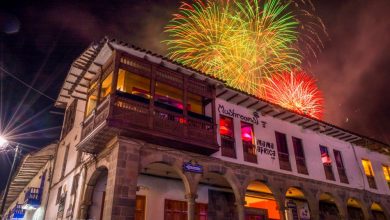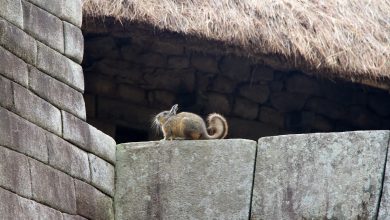
The Inca Museum, in the Admiral’s Palace, is found one block from Cusco’s Plaza de Armas, its Main Square, on Córdova Tucumán Street right next to the San Francisco de Borja School that is where the revolutionary and predecessor of Peruvian Independence, Túpac Amaru II studied.

To visit a mansion with such history is to review a great part of everything that has happened in Peru, from Pre-Inca times, to the Inca epoch and then to the present. When we reached the museums doorway, we overheard foreigners and Peruvians talking about what they had seen. The asked how could the Incas have done all this and how it happened such that it is all a memory now. One by one and in groups they crossed the main door out of the museum unable to leave it all behind.
On entering the museum, you first see on the red carpeted walk way the statue of an Inca with open arms welcoming the visitors. Next to him is a robe with Inca colors and designs. In letters this shows the Palace of the Admiral as the Inca Museum. The combination is intriguing. A elite Spanish colonial palace introduces us to the Inca past.
The old mansion and its different spaces are impressively maintained even though much time has passed. On the cream colored walls are displayed paintings and images of archeological complexes and of the people of the Inca Empire. In the building’s middle, the patio shows off a fountain carved in stone with images of lions. Under its portals on the first and second floors you find a parade of cloth and big ceramic jugs which draws our attention to enter each different room. The whole building preserves faithfully the Spanish style of the XVI to the XVII centuries. Even though it is very Spanish, it hold and shows us the Inca world.

The Museum has 16 display rooms where are shown three phases of the culture of Tawantinsuyo, as the land of the Inca Civilization is known—the Pre-Inca, Inca, and Republican Colonial—as well as object in stone, clay, wood, fabric and metal. You can also appreciate models of various urban spaces and the architecture of the archeological complexes of Choquequirao, Maras Moray, the Qoricancha Temple, the straw bridge of Keswachaka, and the marvel of Machupicchu. Each comes with a description.

The first three rooms on the first floor show eaxamples of artifacts of Pre-Inca cultures from beyond Cusco. They hold in their glass cases displays of ceramics, pots, big jars, and ceremonial cups from the Pre-Inca cultures of Chancay, Moche, and Nazca, all dating to around 500 AD. You also see a map of Collasuyo with its description. All of this is interesting but what made me stop to contemplate carefully were the monoliths carves in stone in the form of a puma and of the stones of Pucará. These are still intact and are well protected behind the glass of the exhibits.

People inside the Museum show themselves impressed by the art and the articles exhibited. At each display case they stop to read and to learn a bit about the great Inca Empire.
Inside the third room, a spiral staircase takes us up to the second floor which is divided into a long passageway with three rooms. With each step you can appreciate the models that show the environment and the production of foods in the department of Cusco and its three regions, the Yunca, Qeswa and Puna.
As we enter the room we can see the evolution of the History of the Cusco Region, with its beginning of groups who first inhabited the valley some 5000 BC. We also see the peoples of Espinar, Chawaytiri, and more. The rooms explain through archeology the evolution of the Valley of Cusco in archaic times. Then we see the Regional States of Cusco beginning with the Chanapata and Marcavalle cultures, followed by the Qotocalli, Lucre, and Killque.
As we go on, we see ceremonial objects made from clay, such as bowl, plates, and illas that belonged to the Inca Culture at its height. The images on the walls give us an idea of how the great Machupicchu was made. We could also see the evidence of the utensils used to make the great works of the city of Choquequirao.

While remembering and living the Inca Epoch, we pass to the room of mummies where que can develop and idea through observation of Inca burials. It is a bit chilling as are the trepanations, the skull surgeries, showing us the great advance of medical knowledge in those days.
It was wonderful to review this part of Inca history since they have given us an exceptional legacy which we must respect and take care of. We must also teach our children about our roots. Nevertheless, we must also recognize he change they suffered with the coming of the Spanish in 1533. As a result, the following rooms show us the changes made with the coming of the Westerners, in art, culture, living systems, traditions, and more.

It was a change that affected us strongly as a culture, but we survived it and, despite time, we have known how to bring them together for survival.
The Inca Museum is also known as the Archeological Museum of the UNSAAC (the National University of San Antonio Abad del Cusco). It is the most complete in the city with ample sized thematic rooms. The entrance price is 10 /S per adult and 5/S per child. For the people of Cusco it is free with the presentation of your DNI, your identity card.
The Admiral’s Palace is without doubt a great example of colonial architecture in the city. The mansion belonged to one of the illustrious families of the conquistadores, the Maldonado family and before them belonged to the Inca Huascar. The family scoat of arms can be seen on the mansion’s entrance.





